Eastern equine encephalitis (EEE), commonly called Triple E or sleeping sickness, is a disease caused by a zoonotic mosquito-vectored Togavirus that is present in North, Central, and South America, and the Caribbean. EEE was first recognized in Massachusetts, United States, in 1831, when 75 horses died mysteriously of viral encephalitis. Epizootics of EEE in horses have continued to occur regularly in the United States. It can also be identified in donkeys and zebras. Rarely, it can also infect humans. Due to the rarity of the disease, its occurrence can cause economic impact beyond the cost of horses and poultry. EEE is found today in the eastern part of the United States and is often associated with coastal plains. It can most commonly be found in East Coast and Gulf Coast states. In Florida, about one to two human cases are reported a year, although over 60 cases of equine encephalitis are reported. In years in which conditions are favorable for the disease, the number of equine cases is over 200. Diagnosing equine encephalitis is challenging because many of the symptoms are shared with other illnesses and patients can be asymptomatic. Confirmations may require a sample of cerebrospinal fluid or brain tissue, although CT scans and MRI scans are used to detect encephalitis. This could be an indication that the need to test for EEE is necessary. If a biopsy of the cerebrospinal fluid is taken, it is sent to a specialized laboratory for testing.

Heloxycanus patricki, also known as the sphagnum porina moth, is a species of moth of the family Hepialidae, the ghost moths. It is the only member of the genus Heloxycanus. This species is endemic to New Zealand. It has been classified as having the status of "At Risk, Declining" by the Department of Conservation.

Culiseta is a genus of mosquitoes. Most Culiseta species are cold-adapted, and only occur in warmer climates during the colder parts of the year or at higher elevations where temperatures are lower. Species found in Southern California are larger than most mosquitoes species, specifically Cs. inornata, Cs. particeps, and Cs. incidens. These species are found throughout the year in Southern California and feed on several vertebrate species, such as birds, livestock, rodents, reptiles, and humans. The larvae of most species are found bogs, marshes, ponds, streams, ditches, and rock pools, but an African species occurs in tree holes ("phytotelmata"), a common eastern Palaearctic species occurs in water wells and rock pools, and several Australian species occur under ground. Little is known about the blood-feeding habits of females. Most species feed on birds and mammals, but a few feed on reptiles. Several species attack domestic animals and occasionally humans, and some species are pollinators.
Stigmella maoriella is a species of moth in the family Nepticulidae. It is endemic to New Zealand. It is classified as Not Threatened by the Department of Conservation.

Stigmella progama is a species of moth in the family Nepticulidae. This species is endemic to New Zealand. It is classified as "Data Deficient" by the Department of Conservation. S. progama has only been collected on Bold Peak in Otago.
Stigmella propalaea is a species of moth in the family Nepticulidae. It is endemic to New Zealand. This species is classified as "Data Deficient" by the Department of Conservation.

Eudonia bisinualis is a species of moth in the family Crambidae. It was described by George Vernon Hudson in 1928. This species is endemic to New Zealand.
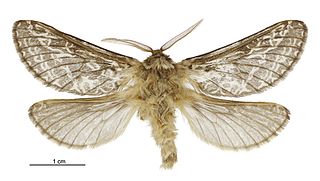
Aoraia aspina is a species of moth of the family Hepialidae. It was described by John S. Dugdale in 1994 from specimens collected in the Tasman, Otago and Southland districts. It is endemic to New Zealand.
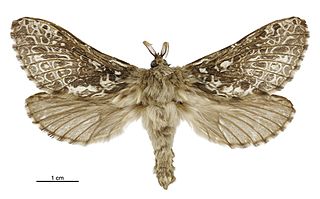
Aoraia aurimaculata is a species of moth of the family Hepialidae. It was described by Alfred Philpott in 1914 from a specimen collected at The Hermitage, Mount Cook by F. S. Oliver. This holotype specimen is now lost. A. aurimaculata is endemic to New Zealand,

Aoraia flavida is a species of moth from the family Hepialidae. It is endemic to New Zealand. This species was described by John S. Dugdale in 1994 from specimens obtained near Gem Lake in the Umbrella Mountains in Southland and collected by B. H. Patrick.
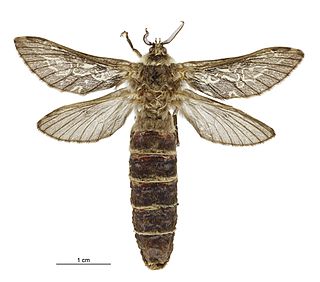
Aoraia orientalis is a species of moth of the family Hepialidae. It is endemic to New Zealand and is found in eastern Central Otago. It was described by John S. Dugdale in 1994.

Aoraia senex is a species of moth of the family Hepialidae. It is endemic to New Zealand, where it is known from the South Island. This species was first described by George Vernon Hudson in 1908 from specimens discovered by J. H. Lewis in Central Otago.

Dioxycanus oreas is a species of moth of the family Hepialidae. It is endemic to New Zealand. It was first described by George Vernon Hudson in 1920. The species was discovered by Averil Lysaght.

Dumbletonius unimaculatus, also known as the forest ghost moth, is a species of moth of the family Hepialidae. It is endemic to New Zealand. This species is host to the vegetable caterpillar fungus Ophiocordyceps robertsii.

Orthoclydon praefectata, the flax looper moth or flax window maker, is a moth of the family Geometridae. It is endemic to New Zealand.

Ericodesma cuneata, the Corokia leafroller moth, is a species of moth in the family Tortricidae. It is endemic to New Zealand. This moth is classified as "At Risk, Naturally Uncommon" by the Department of Conservation.

Pyrgotis chrysomela is a species of moth of the family Tortricidae. It is endemic to New Zealand.
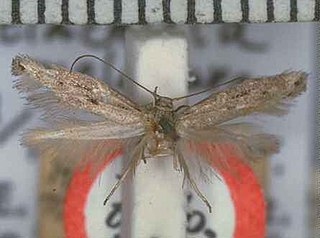
Elachista melanura is a species of moth in the family Elachistidae. This species is endemic to New Zealand. It is classified as "Data Deficient" by the Department of Conservation.

Adeixis griseata is a species of moth of the family Geometridae. It is endemic to New Zealand and has been collected in the North, South and Chatham Islands. This species inhabits poorly drained or swampy areas. As at 2017 the host plant of this species is unknown however it has been hypothesised that the host plant may be Schoenus brevifolius or another common sedge. Adults have been observed on the wing from October until January.
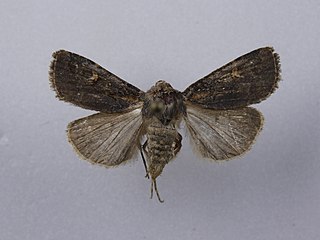
Proteuxoa tetronycha is a moth of the family Noctuidae. It is endemic, and can be found throughout, New Zealand. This species was previously muddled up with the rarer Proteuxoa comma and is very similar in appearance to that other species. P. tetronycha can be distinguished from P. comma by the paler colour of its prothorax as well as the browner base colour of its forewings. P. tetronycha is also a smaller moth with the wingspan of the adults of this species being between 29 and 33 mm. There are also differences between the females of these two species. For the females of P. tetronycha, their ovipositor is lacking the spiny hair like structures that are present on the ovipositor of P. comma. Larvae likely feed on a variety of host species and have been raised on Acaena species as well as Poa cita. The adults of this species are on the wing from September to March and are attracted to light.
















